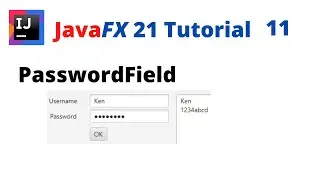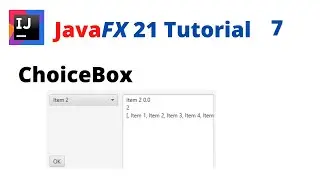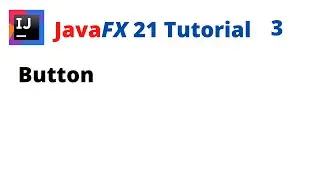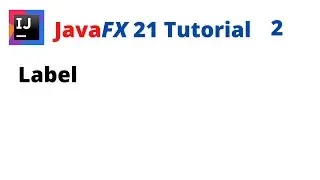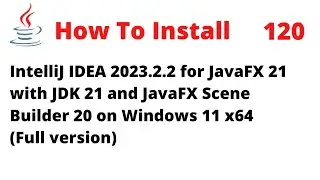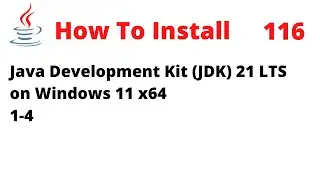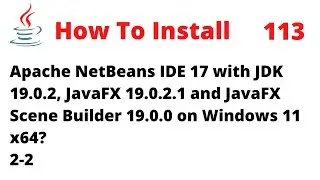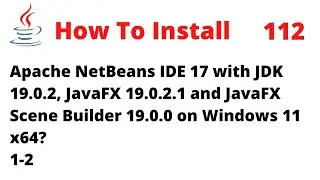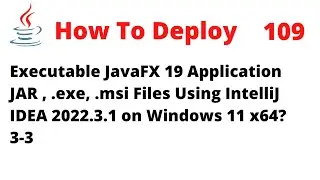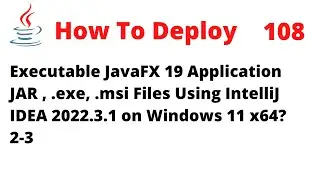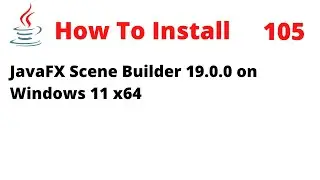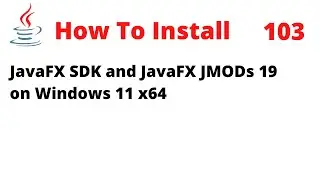JavaFX 15 Tutorial 66 - exe and msi Installer for JavaFX 17 Application Using JPackage
In this tutorial, I will show you how to use the JPackage to produce a self-contained JavaFX or Java application includes all the necessary dependencies. It allows us to produce a native package in an exe or msi on Windows 11 x64.
The options are as follows.
--type
The type of package to create
--input
Path of the input directory that contains the files to be packaged
--dest
Path where generated output file is placed
--main-jar
The main JAR of the application containing the main class
--main-class
Qualified name of the application main class to execute.
--module-path
The path to modular jars
--add-modules
Add list of modules
--win-shortcut
Creates a desktop shortcut for the application.
--win-menu
Adds the application to the system menu.
Source:
https://docs.oracle.com/en/java/javas...
You should download and install the following:
- JDK 17.0.1 is available from https://www.oracle.com/java/technolog...
- Open JavaFX (OpenJFX) and JMODS 17.0.1 are available from https://gluonhq.com/products/javafx/
- Java Scene Builder 17.0.0 is available from https://gluonhq.com/products/scene-bu...
- IntelliJ IDEA Community Edition 2021.3 is available from https://www.jetbrains.com/idea/download/
- WiX Toolset v3.11.2 is available from https://wixtoolset.org/releases/
The Installed directories are as following:
C:\Program Files\Java\jdk-17.0.1
C:\Program Files\Java\javafx-sdk-17.0.1
C:\Program Files\Java\javafx-jmods-17.0.1
C:\Users\Ken\AppData\Local\SceneBuilder
C:\Program Files\JetBrains\IntelliJ IDEA Community Edition 2021.3
C:\Program Files (x86)\WiX Toolset v3.11
VM options:
--module-path "C:\Program Files\Java\javafx-sdk-17.0.1\lib"
--add-modules javafx.controls,javafx.fxml
JDK 17.0.1
JavaFX 17.0.1
JavaFX SceneBuilder 17.0.0
IntelliJ IDEA 2021.3
Windows 11 x64
JPackage command:
jpackage --input . --main-jar JavaFXHelloWorld.jar --main-class com.example.javafxhelloworld.App --module-path "C:\Program Files\Java\javafx-jmods-17.0.1" --add-modules javafx.controls,javafx.fxml
The following defaults are applied:
- The default type of package generated is exe.
- The name of the package generated is App-1.0.exe.
- The package is written to the current directory.
- The main JAR of the application containing the main class is JavaFXHelloWorld.jar
- The name of the application main class to execute is com.example.javafxhelloworld.App.
- The path to modular jars is "C:\Program Files\Java\javafx-jmods-17.0.1".
- The name of added list of modules are javafx.controls,javafx.fxml.
- The runtime packaged with the application is generated as part of the packaging process.
- The application is installed in the c:\Program Files\App directory.
- The name of the launcher is App.exe.
- The default icon is used for the application.
- No shortcut is created, and the application is not added to any menu. The user must go to the directory in which the application is installed to run it.
- No default arguments or Java runtime options are passed to the application when
it is started.
jpackage --type exe --input . --dest . --main-jar .\JavaFXHelloWorld.jar --main-class com.example.javafxhelloworld.App --module-path "C:\Program Files\Java\javafx-jmods-17.0.1" --add-modules javafx.controls,javafx.fxml --win-shortcut --win-menu
The following defaults are also applied:
- The default type of package generated is exe.
- The desktop shortcut is created, and the application is added to the Start menu.
jpackage --type msi --app-version "2.0" --input . --dest . --main-jar .\JavaFXHelloWorld.jar --main-class com.example.javafxhelloworld.App --module-path "C:\Program Files\Java\javafx-jmods-17.0.1" --add-modules javafx.controls,javafx.fxml --win-shortcut --win-menu
The following defaults are also applied:
- The default type of package generated is msi.
- The application version is changed to "2.0.








